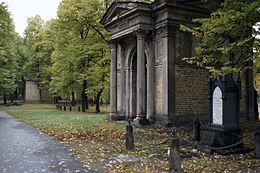Great Cemetery (Riga)

Mausoleum of C. H. Berg in Riga's Great Cemetery
|
|
| Details | |
|---|---|
| Established | 1773 |
| Location | Riga |
| Country | Latvia |
| Coordinates | 56°58′16″N 24°08′40″E / 56.970995°N 24.144344°E |
| Type | Closed, 1957 |
| Owned by | Evangelical Lutheran Church of Latvia |
| Size | 22 hectares (54 acres) |
The Great Cemetery (Latvian: Lielie kapi; German: Grosser Friedhof) was formerly the principal cemetery of Riga in Latvia, established in 1773. It was the main burial ground of the Baltic Germans in Latvia.
Extensive damage and removal of many headstones and graves by the Soviet authorities governing the Latvian SSR after 1945 led to the suspension of burials and the eventual conversion of the burial ground to a public park. Despite this, a significant number of old graves have survived.
The 22-hectare property is owned by the Latvian Evangelical Lutheran Church.
Between 1771 and 1772, Catherine the Great, empress of the Russian Empire, decreed that no-one, regardless of their social standing or class origins, was to be buried in a church crypt or churchyard; all burials were to take place in the new cemeteries to be built throughout the entire Russian empire, which were to be located outside town boundaries. These measures were intended to overcome the congestion of urban church crypts and graveyards, and were prompted by a number of outbreaks of highly contagious diseases linked to inadequate burial practices in urban areas, especially the black plague which had led to the Plague Riot in Moscow in 1771.
Against this background the Great Cemetery in Riga was founded in 1773. It served as a burial ground for over 170 years for almost all Baltic Germans who died in the city between 1773 and 1944. Additionally, numerous Latvians of upper social status were buried there as well. The cemetery was divided into three section: Lutheran, Roman Catholic, and Orthodox Christian.
...
Wikipedia
